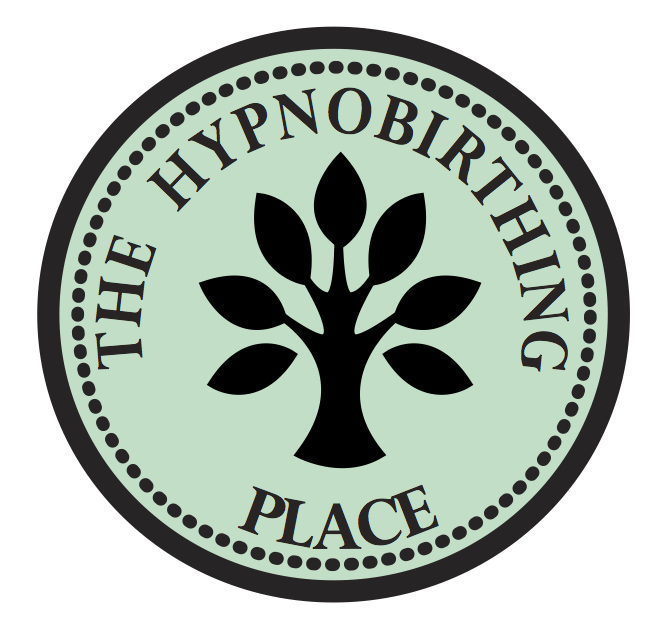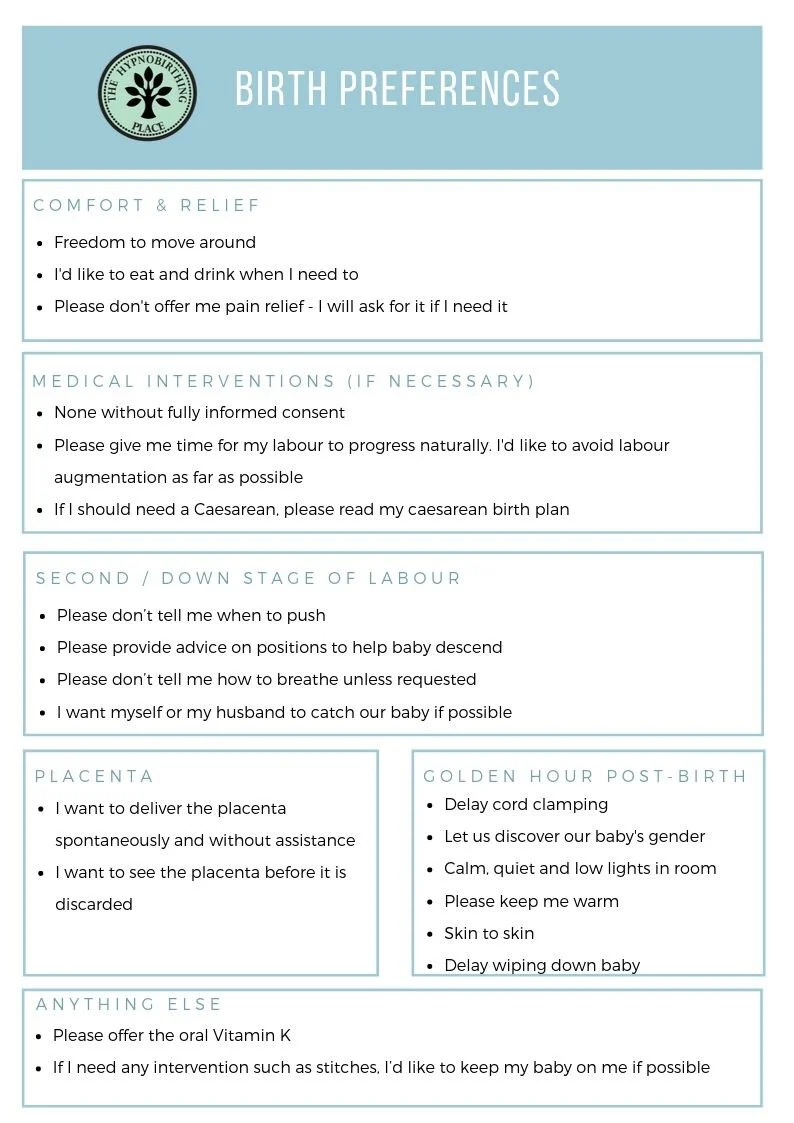How to write your Hypnobirthing Birth Plan - and why it's worth doing
This post is about helping you to write your birth plan and includes a FREE hypnobirthing birth plan which you can download. I’ll also address some of the key questions that frequently crop up during my courses, such as:
Is it worth writing a ‘Birth Plan’? Should it be called ‘Birth Preferences’ instead? And if I do want to write one, what might I put in it? Is a hypnobirthing birth plan different?
If you’ve been asking any of these questions, I hope you’ll find some answers here.
What is a birth plan?
A birth plan is a document that sets out how you want your labour to be and what you’re aiming for.
There are many factors involved in your labour, and many choices you can make that will positively influence your birth experience, such as the environment you give birth in and your choices about the care you receive, amongst other things.
Please remember you have human rights in childbirth. This means nothing can happen to you without fully informed consent.
Proactively researching your options and setting out how you want labour to be in advance means you can make informed decisions, helping you feel empowered, however birth goes.
You write your birth plan whilst pregnant and discuss it with your midwife / obstetrician in advance of labour. During birth itself, your plan provides guidance to your caregivers so they can support you effectively in labour and follow your requests.
‘But is it worth writing a ‘birth plan’?
Some believe not. In fact, you might be warned against making a plan for birth, because birth is ‘too unpredictable’. A friend recently told me she felt making a birth plan would be ‘setting herself up for failure’.
Photo by Dexter Chatuluka on Unsplash
I find this pretty depressing. As with anything in life, the fact is if you choose what you’d like to aim for, there is always a chance that you might not get it. But it’s worth a try, isn’t it?
But I think that there’s an important issue that needs to be addressed here. It’s the idea that if you make a rigid birth plan and you are very wedded to it, then if things don’t go to plan (because birth can be unpredictable) you might end up feeling like a failure. This IS something I’ve witnessed, particularly during my early days of teaching.
It’s linked into a broader concern, which is that many women put a lot of pressure on themselves in life generally.
We like to set our expectations sky high and then feel terrible when we don’t reach them. So if a woman with a birth plan focused solely on a natural water birth ends up needing medical intervention or pain relief, she might well feel like a failure; which is something we want to avoid at all costs.
This is why I spend A LOT of time talking about the importance of letting go of pressure in my Hypnobirthing classes. Our focus is on cultivating self-belief with kindness and compassion.
This means acknowledging that we can’t control birth, and that it is just as important to maintain flexibility, and an open mind.
During labour, these qualities are just as vital as being able to stay calm and relaxed. Thus a birth plan should incorporate this flexibility and cover off more than one way to do things.
Hence why some people prefer to use the term ‘Birth Preferences’ rather than ‘Birth Plan’. And so…
Is it better to call a ‘Birth Plan’ a list of ‘Birth Preferences’?
For me, it’s about how you attach meaning to a word. I have no problem with the word ‘plan’, because I know that plans have to change sometimes. If there’s one thing parenting has taught me, it’s that!
Equally, ‘Preferences’ keeps things more open and gives greater scope for change, so you might feel more comfortable using this terminology instead. You’ll see I’ve used it on the template below.
Ultimately, it’s your choice entirely, and you must use the term you’re most comfortable with.
Why is a birth plan important?
Photo by Thought Catalog on Unsplash
Three reasons why I think it’s important to write a birth plan.
Whilst we can’t control birth, we CAN influence it.
Despite the fact that birth can be unpredictable, it is still useful and empowering to consider what you’d like to aim for. This will include the factors that are within your control, that will influence your birth positively.
Things like how you want the environment to feel, what approach you’d like the midwife to take with you, how you feel about monitoring, pain relief, medical interventions, giving birth to the placenta, to name but a few.
Giving birth is primal and physically all-encompassing, so you don’t want to be considering and interrogating all your options during labour itself. You want to be rooted in your body, riding those birth waves, not in your rational brain… when you are calm and ‘switched off,’ the hormones that propel labour along can flow.
Having to answer lots of questions and make quick rational decisions during birth is difficult, distracting and takes you out of your zone.
2. It helps you prepare for the unexpected.
If your labour takes an unexpected turn, you/your partner can pass your plan to your midwife and ask what could still be possible, and you might be surprised at how much still is.
3. It’s a very useful tool for your birth partner.
Your birth partner is your advocate during labour. A birth plan gives them something they can regularly refer to and point out to midwives, particularly if midwives suggest things that aren’t in the plan. This helps your birth partner in their role as gatekeeper and intermediary between you and your caregivers, leaving you to focus on giving birth.
What should a birth plan include?
A birth plan needs to be flexible and doesn’t put pressure on you to do things a certain way. Remember, there is no ‘right or wrong’ birth plan.
Below you’ll find suggestions for things to go into your plan.
Consider your options, accept that you won’t necessarily be able to cover off everything but that you will include all or most of the choices that are important to you.
To help you think about what you want to include, I’ve designed a birth plan template which you can download for FREE and fill in with your unique set of preferences.
Is this a Hypnobirthing birth plan?
Yes, this plan includes elements from Hypnobirthing, such as the sort of atmosphere you’d like to create. However, you’ll see that whether you are hypnobirthing or not, there are options here to suit you.
Here is a Hypnobirthing birth plan example.
Writing your birth plan
Below is a list of prompts to go with each section of the plan. It’s ideal if you discuss these with your birth partner as you make your birth plan together.
I also highly recommend the visual birth plan icons which you can download for free from Pinter and Martin - to use in the birth plan template I’ve created for you. They are easy for your caregivers to understand quickly, and very helpful prompts for your birth planning too.
Important info
· If this is your first, second or third baby
· Any relevant medical conditions
· Previous experiences which might impact on your experience with your caregivers
Calm environment:
A dimly lit, quiet and calm environment will keep you relaxed and help your labour progress quickly and smoothly.
· Music played (Lioness, Hypnobirthing relaxations or other)
· Low lights
· The room as quiet as possible (minimal talking)
· As few interruptions as possible
· To remain undisturbed, with as few vaginal exams as possible / no vaginal examinations unless requested or deemed absolutely necessary, with consent / Regular routine vaginal examinations
· Birth pool
· Medical students with permission / no medical students
Language
Language has a huge effect on how we feel, which is something we discuss a lot in our hypnobirthing classes. It’s a good idea to let your midwives know if there are certain words you’d like them to use or avoid, the aim being to help you feel positive and confident about your labour.
See the Hypnobirthing Birth plan for examples of what could go in here.
Monitoring
Your baby’s heartbeat and wellbeing can be monitored during labour in several ways. If there are no concerns about you or your baby, they will most likely use a doppler which is held to your abdomen to check baby’s heartbeat using ultrasound waves. Most dopplers work under water too. if there are any concerns about you or your baby, you’ll be offered Continuous Electronic Foetal Monitoring (CEFM) which will be strapped to your bump and connected to the CTG (cardiotograph). Some hospitals have wireless CTG machines so you can stay mobile instead of strapped to the bed.
· Baby’s heartbeat checked at my request
· Continuous monitoring of heartbeat (CTG) / Avoid using CTG unless absolutely necessary
· Regular monitoring of baby's heartbeat with doppler (or alternative)
· Monitoring not to interfere with my ability to move around
· If CTG, is deemed necessary, and I consent to it, I would prefer wireless if possible, so I can stay mobile
Comfort and relief
· Freedom to move around
· To eat and drink when I need to
Whilst hypnobirthing will help your labour to be as comfortable as possible, there are various pain relief options to choose from if needed. We’re lucky to have access to them! You may not feel the need to ask for pain relief, but don’t put pressure on yourself to avoid them – they don’t contradict hypnobirthing.
· Please don't offer me pain relief - I will ask for it if I need it
· Please offer me pain relief if I ask for it. This includes:
· Gas and air
· Epidural
· Opioid pain relief
Medical interventions (if necessary)
· None without fully informed consent
· Please give me time for my labour to progress naturally. I'd like to avoid labour augmentation as far as possible
Labour augmentation (to speed up labour)
· Request consent before breaking my waters / do not break my waters
· Syntocinon if necessary / No syntocinon augmentation
· Caesarean preferred to syntocinon
Assisted delivery
· Assisted delivery if required, with consent (forceps / ventouse)
· Caesarean preferred to assisted delivery
· If I should need a Caesarean, please read my caesarean birth plan (featuring in my next blog post)
Second / down stage of labour
· Please provide encouragement and guidance for pushing stage
· Please don’t tell me when to push
· Please provide advice on positions to help baby descend
· Please don’t provide advice on positions unless requested
· Please don’t tell me how to breathe unless requested
· Please provide guidance on how to breathe
· I want the midwife / my birth partner to catch my baby
· I want to catch my baby myself
Placenta
After birth, mothers are often offered an injection of articficial oxytocin to cause uterine contractions and help with a fast delivery of the placenta. This may interrupt your flow of natural oxytocin so it’s worth considering before you give or decline consent to be given the injection.
· I want to deliver the placenta spontaneously and without assistance
· I want to be offered the injection for placenta delivery
· I want / do not want to see the placenta before it is discarded
· I want to keep my placenta
Golden hour post-birth
Gender
· Please let me / us / my partner discover the gender of my baby
· Please tell us the gender of our baby
· We already know the gender of our baby
Cord
· Delayed, optimal cord clamping
· Myself / partner to cut cord
· I want to bank the cord blood
· I want to donate the cord blood
Environment post-birth
· Maintain calm, quiet and dark environment
· Please keep me warm
Skin to skin (smoothing the transition for baby, helping build the bond between you and to establish breast feeding)
· I want immediate skin to skin
· I want my partner to have skin to skin if I am unable to do so
· If I need any intervention such as stitches, I’d like to keep my baby on me if possible
Baby
· Please don’t wash or wipe baby down
· Please wipe my baby down
· Delay weighing and measuring baby
· Please offer the Vitamin K injection (ideally preservative free)
· Please offer the oral Vitamin K
· We do not want our baby to be given Vitamin K
Please click here to download your free hypnobirthing birth plan template / birth preferences template.
Feel free to share this with anyone who’d benefit from it and I’d love to hear your thoughts - especially if you’ve made use of it yourself!
Zoe x
photo by Julie Johnson on Unsplash






